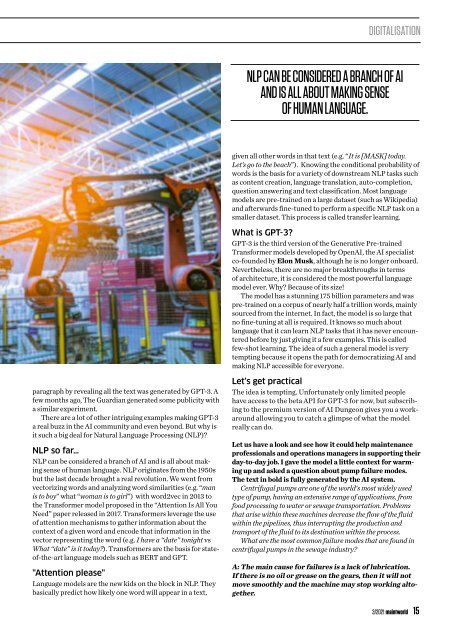Maintworld Magazine 3/2021
- maintenance & asset management
- maintenance & asset management
You also want an ePaper? Increase the reach of your titles
YUMPU automatically turns print PDFs into web optimized ePapers that Google loves.
DIGITALISATION<br />
NLP CAN BE CONSIDERED A BRANCH OF AI<br />
AND IS ALL ABOUT MAKING SENSE<br />
OF HUMAN LANGUAGE.<br />
given all other words in that text (e.g. “It is [MASK] today.<br />
Let’s go to the beach”). Knowing the conditional probability of<br />
words is the basis for a variety of downstream NLP tasks such<br />
as content creation, language translation, auto-completion,<br />
question answering and text classification. Most language<br />
models are pre-trained on a large dataset (such as Wikipedia)<br />
and afterwards fine-tuned to perform a specific NLP task on a<br />
smaller dataset. This process is called transfer learning.<br />
What is GPT-3?<br />
GPT-3 is the third version of the Generative Pre-trained<br />
Transformer models developed by OpenAI, the AI specialist<br />
co-founded by Elon Musk, although he is no longer onboard.<br />
Nevertheless, there are no major breakthroughs in terms<br />
of architecture, it is considered the most powerful language<br />
model ever. Why? Because of its size!<br />
The model has a stunning 175 billion parameters and was<br />
pre-trained on a corpus of nearly half a trillion words, mainly<br />
sourced from the internet. In fact, the model is so large that<br />
no fine-tuning at all is required. It knows so much about<br />
language that it can learn NLP tasks that it has never encountered<br />
before by just giving it a few examples. This is called<br />
few-shot learning. The idea of such a general model is very<br />
tempting because it opens the path for democratizing AI and<br />
making NLP accessible for everyone.<br />
paragraph by revealing all the text was generated by GPT-3. A<br />
few months ago, The Guardian generated some publicity with<br />
a similar experiment.<br />
There are a lot of other intriguing examples making GPT-3<br />
a real buzz in the AI community and even beyond. But why is<br />
it such a big deal for Natural Language Processing (NLP)?<br />
NLP so far…<br />
NLP can be considered a branch of AI and is all about making<br />
sense of human language. NLP originates from the 1950s<br />
but the last decade brought a real revolution. We went from<br />
vectorizing words and analyzing word similarities (e.g. “man<br />
is to boy” what “woman is to girl”) with word2vec in 2013 to<br />
the Transformer model proposed in the “Attention Is All You<br />
Need” paper released in 2017. Transformers leverage the use<br />
of attention mechanisms to gather information about the<br />
context of a given word and encode that information in the<br />
vector representing the word (e.g. I have a “date” tonight vs<br />
What “date” is it today?). Transformers are the basis for stateof-the-art<br />
language models such as BERT and GPT.<br />
"Attention please"<br />
Language models are the new kids on the block in NLP. They<br />
basically predict how likely one word will appear in a text,<br />
Let’s get practical<br />
The idea is tempting. Unfortunately only limited people<br />
have access to the beta API for GPT-3 for now, but subscribing<br />
to the premium version of AI Dungeon gives you a workaround<br />
allowing you to catch a glimpse of what the model<br />
really can do.<br />
Let us have a look and see how it could help maintenance<br />
professionals and operations managers in supporting their<br />
day-to-day job. I gave the model a little context for warming<br />
up and asked a question about pump failure modes.<br />
The text in bold is fully generated by the AI system.<br />
Centrifugal pumps are one of the world's most widely used<br />
type of pump, having an extensive range of applications, from<br />
food processing to water or sewage transportation. Problems<br />
that arise within these machines decrease the flow of the fluid<br />
within the pipelines, thus interrupting the production and<br />
transport of the fluid to its destination within the process.<br />
What are the most common failure modes that are found in<br />
centrifugal pumps in the sewage industry?<br />
A: The main cause for failures is a lack of lubrication.<br />
If there is no oil or grease on the gears, then it will not<br />
move smoothly and the machine may stop working altogether.<br />
3/<strong>2021</strong> maintworld 15

















